Wednesday, August 13, 2025. Annette’s Roundup for Democracy.
Washington, D.C. under siege.
“Don’t let your kids go out alone.”
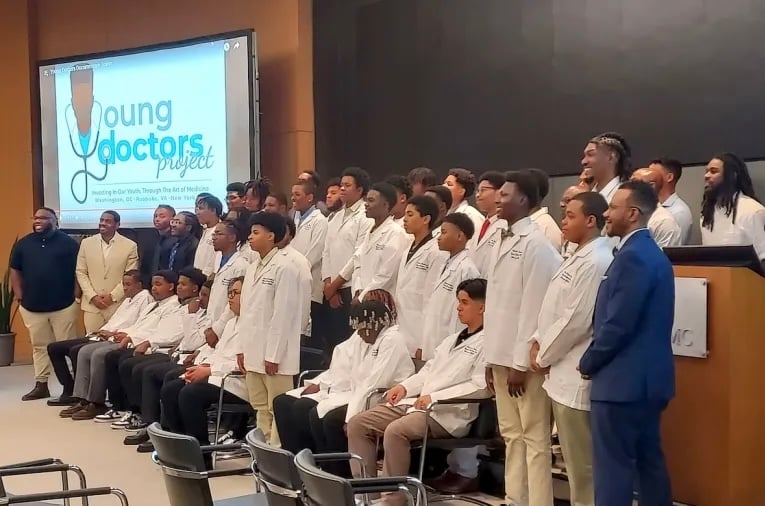
Young men participating in the Young Doctors Project White Coat Ceremony at Howard University on June 23. Did they walk on the streets of D.C. to get there? Will they be able to do this next week?
Yesterday, Donald Trump invaded D.C., placing the city under military control.
We know his record. In 2020, he incited his followers to storm our Capitol—the same building our second president, John Adams, called “the capital of a great nation advancing with unexampled rapidity in arts, in commerce, in wealth, and in population.”
Trump has no interest in advancing these United States as a great nation. He has no respect for the seat of our government—only a hunger for power and control.
And make no mistake: his focus on cities is not about fighting crime. It’s about silencing the liberal majorities who oppose him. Washington is the easiest target—no governor, no independent National Guard, no state-level resistance.
It’s about silencing the black majorities who oppose him. According to U.S. Census data, of the 342 U.S. cities with populations over 100,000, 19 are majority Black and another 46 have Black populations between 30% and 50%. Those demographics tell you why Trump wants control.
On Monday, Trump federalized the D.C. police department, deployed 800 National Guard troops, and told them they could “do whatever the hell they want.” Pentagon plans made clear he has larger ambitions too - to establish a “Domestic Civil Disturbance Quick Reaction Force” composed of hundreds of National Guard troops tasked with rapidly deploying into American cities facing protests or other unrest.(source. Washington Post)
At his press conference, he described D.C. as “overtaken by violent gangs and bloodthirsty criminals, roving mobs of wild youth, drugged-out maniacs, and homeless people”—even holding up a chart comparing the city’s murder rate to some of the most violent regions in South America.
Jeanine Pirro, now Trump’s U.S. attorney for D.C., added: “The laws are weak. I can’t touch you if you’re 14, 15, 16, 17 years old and you have a gun.”
It’s that phrase of Trump’s —“mobs of wild youth”—and Pirro’s targeting of teenagers that frightens me most. The subtext is clear: young Black men and women in D.C. will be presumed dangerous simply for walking their own streets. I fear we will soon hear of unarmed boys—urban Trayvon Martins—gunned down without provocation, or young women brutalized for daring to mouth off about their rights.
Don’t be fooled. This isn’t about law and order. It’s about power, fear, and an appeal to racists in Trump’s base.
It’s about who gets to walk free in our nation’s capital. (Annette Niemtzow)
Trump plays the Carnage Card.
Fake crime wave, real power grab.
First, some personal news. For those who may not know, I received a great honor this weekend:

I have now added “Deranged BUM” to my Substack profile.
But enough about me. Let’s move on to the subject of today’s post, Trump’s takeover of Washington, DC, where he has seized control of the city’s police force and sent in the National Guard.
Actually, there’s some relationship between Trump’s rage-tweeting about yours truly and his move against the nation’s capital.
Ever since that latest weak jobs report, Trump has been frantically trying to convince the American public that the economy is doing great. He is failing, and predictably so. Experience shows that trying to talk up the economy when people don’t perceive it as good never works, even if the data are favorable. It’s even less likely to work when the data actually aren’t good, and calling people who point out economic weakness BUMs isn’t likely to help.
On the other hand, telling people things are bad even when they’re actually good can work. This is sometimes true when it comes to the economy. It’s definitely true when we’re talking about crime.
Our capital city has been overtaken by violent gangs and bloodthirsty criminals, roving mobs of wild youth, drugged out maniacs and homeless people.
He forgot to mention deranged bums. Anyway, the media were in general pretty good at pointing out that crime in DC has in fact been falling rapidly. According to the U.S. attorney’s office, violent crime is at a 30-year low. The invaluable Jeff Asher has a chart:
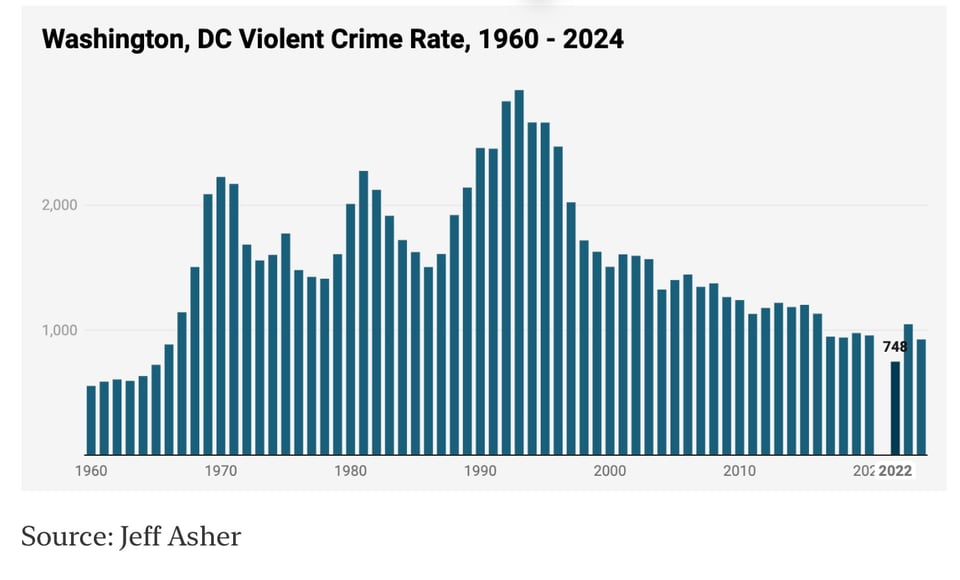
As I understand it, there are some technical data issues for 2022. But the basic picture is that DC is safer than it has been since the 1960s. The same is true for the nation as a whole:
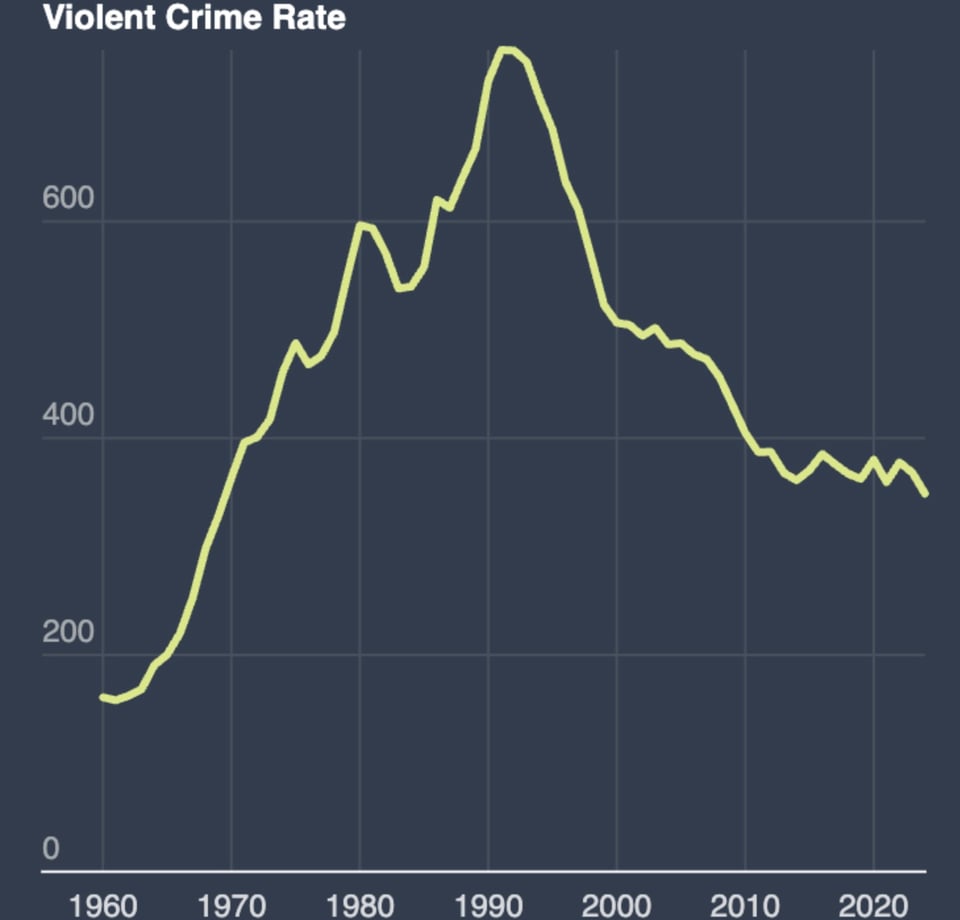
But will Trump be universally ridiculed for his absurd claims? Will people understand that what we’re seeing, aside from an attempt to seize even more power, is an attempt to change the subject from the weakening economy and the Epstein affair?
I’m not sure.
Residents of DC will surely notice that Trump’s description of a violence-ridden dystopia bears no resemblance to the city they actually inhabit. But we know that crime is an issue on which people tend to believe that things are getting worse even when they are getting markedly better.
As you can see from the chart above, there was a truly epic decline in crime from the early 1990s to the mid-2010s. Yet throughout that period, according to Gallup, a large majority of Americans said that crime was getting worse. What’s going on?
One possible answer is that there are lies, damned lies and statistics. Maybe official crime numbers are, as Trump would say, RIGGED — although that would be really hard to do with murders, which are kind of hard either to fabricate or to conceal, and have fallen even more than overall crime. Or maybe people’s lived experience just doesn’t match what the crime data say.
But I don’t buy that explanation, among other things because I’m a New Yorker. Much of the nation sees the Big Apple as a dystopian hellhole, but anyone who actually lives there can tell you that the city feels quite safe — certainly safer than at any earlier point in my adult life.
Or if you don’t consider me a reliable narrator, look at actual behavior. According to Trump officials, people are afraid to ride the subway because they’re terrified of crime. But actual subway ridership has been soaring since Covid. It’s still somewhat depressed on weekdays, in part because remote work means fewer commuters, but weekend ridership — which mostly means people who could choose not to take the subway if they were terrified of crime — is rising fast:
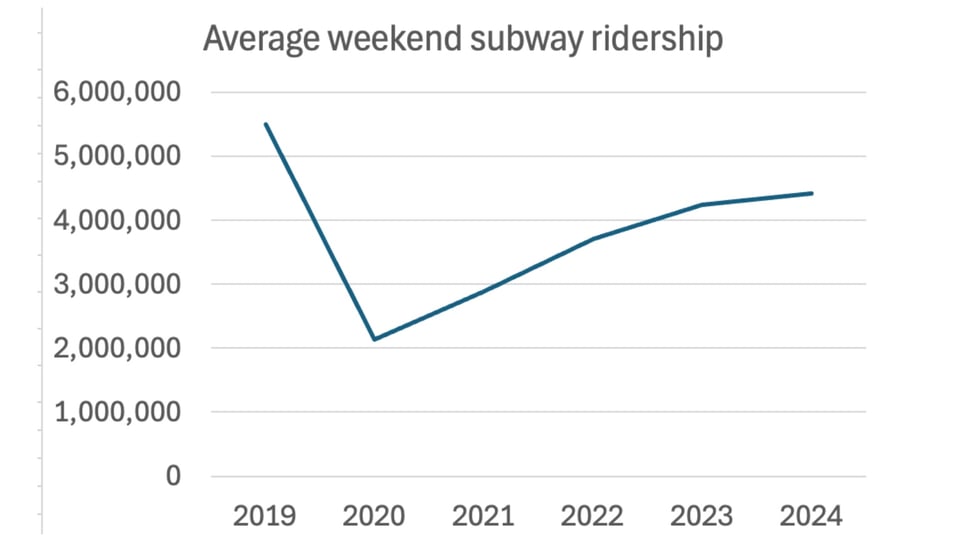
But if the data showing falling crime are accurate, and people aren’t behaving as if they personally are terrified of crime, how can public perceptions about crime trends be so negative?
Part of the answer is the old line “if it bleeds it leads.” There are occasional acts of violence on the New York subway, and they make the news. The system’s overall safety — taking the subway is much, much safer than driving — doesn’t.
But I’d also argue that a large part of the answer is that many Americans believe that crime is running rampant — just not where they happen to live. Fox News tells suburban and small-town Americans that New York and Los Angeles are crime-ridden hellscapes, and they believe it.
According to Gallup, last year 56 percent of Americans believed that crime in the United States was an extremely or very serious problem — but only 14 percent said it was an extremely or very serious problem “in the area where you live.”
Returning for a second to my home subject, we saw something quite similar in assessments of the economy during the Biden years, when American had a much more positive assessment of their local economies than they did of the economy as a whole:
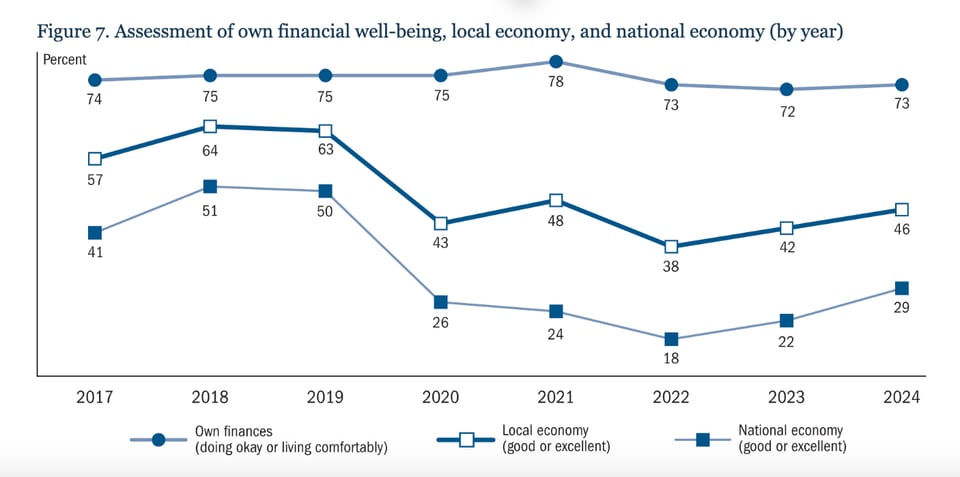
Source: Federal Reserve
Which brings us back to Trump’s claim that he’s seizing power in DC because the city is descending into lawless chaos. Anyone who either lives there are looks at crime data knows that this is malicious nonsense. But we can’t take it for granted that the rest of the country will understand that that he’s lying.
And if I may say, it’s the responsibility of the news media to make that clear. Don’t say “Trump makes contentious claims about DC crime.” Don’t say that there’s “dispute over DC crime data.” Just say that he’s lying. (Paul Krugman, Substack).
Trump’s Power Grab in DC continues.
White House to Vet Smithsonian Museums to Fit Trump’s Historical Vision.
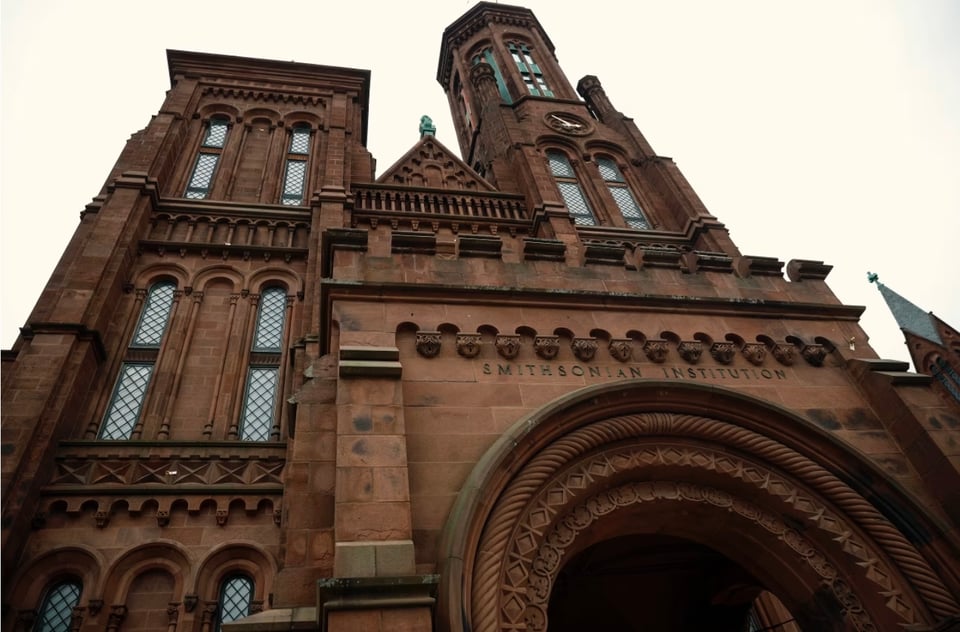
Top White House officials will scrutinize exhibitions, internal processes, collections and artist grants ahead of America’s 250th anniversary.
The White House plans to conduct a far-reaching review of Smithsonian museum exhibitions, materials and operations ahead of America’s 250th anniversary to ensure the museums align with President Trump’s interpretation of American history.
In a letter sent to Lonnie Bunch, the secretary of the Smithsonian Institution, three top White House officials said they want to ensure the museums’ “unity, progress, and enduring values that define the American story” and reflect the president’s executive order calling for “Restoring Truth and Sanity to American History.”
Areas under scrutiny range from public-facing exhibition text and online content to internal curatorial processes, exhibition planning, the use of collections and artist grants.
“This initiative aims to ensure alignment with the president’s directive to celebrate American exceptionalism, remove divisive or partisan narratives, and restore confidence in our shared cultural institutions,” the letter states.
The letter, dated Tuesday, Aug. 12, and viewed by The Wall Street Journal, was signed by White House senior associate Lindsey Halligan, the director of the domestic policy council, Vince Haley, and the director of the Office of Management and Budget, Russ Vought.
“This is about preserving trust in one of our most cherished institutions,” Halligan said in a statement. “The Smithsonian museums and exhibits should be accurate, patriotic, and enlightening—ensuring they remain places of learning, wonder, and national pride for generations to come.”
A spokeswoman for the Smithsonian didn’t respond to a request for comment.
The White House review of the Smithsonian’s massive collection of art and historical artifacts comes as the president has sought to reorient the country’s cultural institutions, including top universities, and demonstrates Trump’s efforts to recast parts of American history in a more positive light.
The Smithsonian’s Board of Regents agreed to conduct a thorough review of all its museum and zoo content to eliminate political influence and bias, the Journal previously reported.
The president singled out the Smithsonian Institution in his executive order and said the Smithsonian had recently “come under the influence of a divisive, race-centered ideology” that promotes “narratives that portray American and Western values as inherently harmful and oppressive.” He directed Vice President JD Vance, a member of the Smithsonian Board of Regents, and senior officials to work with Congress to block the Smithsonian from receiving appropriations for exhibitions and programs that don’t align with his anti-DEI initiatives.
The White House review will pay attention to exhibits planned for the 250th anniversary of the Declaration of Independence. Trump and his team, including Haley, have been intimately involved in the planning for America’s 250th celebrations.
Following the review, the White House letter states that museums should make corrections that replace “divisive or ideologically driven” language with “unifying, historically accurate,” public-facing materials.
But the details requested by the White House go beyond museum exhibitions and extend to organization charts, responses to visitor surveys, artists featured in galleries who have received a Smithsonian grant, a list of outside partners, and internal communications related to exhibit and artwork selection and approval. The museums are given 30 days to turn over requested materials for the initial request.
The White House laid out a timeline for the Smithsonian to tap a representative to work with the administration on 250th anniversary planning. A team from the White House will also be conducting observational visits and walk-throughs of current exhibits to document themes and messaging, and voluntary interviews with curators.
The review will focus on eight of the 19 Smithsonian museums based in Washington: National Museum of American History, the National Museum of Natural History, the National Museum of African-American History and Culture, the National Museum of the American Indian, the National Air and Space Museum, the Smithsonian American Art Museum, the National Portrait Gallery and the Hirshhorn Museum and Sculpture Garden.
The White House stated the review of Smithsonian museums is expected to wrap at the beginning of 2026, according to the
letter. (Wall Street Journal).
Let’s walk back another Trump lie.
Topline
President Donald Trump on Tuesday said his tariffs are taking in “trillions of dollars”—which matches estimates from some economists for revenue his levies could generate, but over the next decade, not so far this year.

Treasury Secretary Scott Bessent has projected tariff revenue would reach $300 billion per year.
Key Facts
“Trillions of dollars are being taken in on tariffs,” Trump wrote on Truth Social, suggesting his levies have “not caused inflation, or any other problems for America, other than massive amounts of CASH pouring into our Treasury’s coffers.”
Trump leaves out that tariffs are paid by U.S. companies to import foreign goods, with those costs eventually paid by U.S. consumers.
How Much Revenue Has The U.s. Collected From Trump’s Tariffs?
The U.S. has collected $142 billion from tariff revenue so far this fiscal year, which ends in September, according to Treasury Department data released Tuesday. Since Trump’s tariffs took effect in April, his levies have generated about $96 billion in revenue, after customs duties jumped to $28 billion in July, marking an annual increase of 273%. Customs duties accounted for $27 billion in revenue for June, $22 billion in May and $16 billion in April. Before Trump’s tariffs were announced, customs duties totaled $8 billion in March and $7 billion in February and January. Customs duties are tariffs or taxes paid by importers in international trade, meaning companies, businesses or individuals in the U.S. are required to pay levies as goods enter the country. Consumers tend to carry the weight of tariff costs as companies adjust prices to offset or absorb the effects of tariffs.
How Much Revenue Will Trump’s Tariffs Generate?
Even Treasury Secretary Scott Bessent told MSNBC earlier this month he expects tariffs would generate $300 billion annually, noting “there’s a chance that could be higher” in 2026. The Tax Foundation projected Trump’s tariffs would raise about $2.5 trillion over the next decade, even as the levies will likely raise the price of common goods and taxes for the average household by nearly $1,300 in 2025 and $1,700 in 2026. The Committee for a Responsible Federal Budget, a public policy nonprofit, expects Trump’s tariffs to generate $2.8 trillion to the U.S. gross domestic product by fiscal year 2034 if they continue.
Have Trump’s Tariffs Influenced Inflation?
Inflation jumped lower than expected to 2.7% in July, though core consumer prices—a measurement that excludes food and energy—rose 3.1% year-over-year, matching a high this year set in January. It appears Trump’s tariffs have raised prices, and some economists have warned his levies could hike costs through the end of the year. JPMorgan Chase’s chief U.S. economist, Michael Feroli, argued in a note earlier this year that Trump’s tariffs would result in “meaningfully larger increases” to consumer prices and higher inflation at some point this year. Federal Reserve Chair Jerome Powell said last month that while the U.S. economy was in a “solid position,” the effects of tariffs on the economy and inflation “remain to be seen.”
Tangent
Trump said last month his administration would “consider” sending checks based on the revenue his tariffs have generated. Sen. Josh Hawley, R-Mo., introduced a bill after Trump signaled interest in a rebate check, which would send at least $600 to each eligible adult and dependent child this year. A larger rebate check would be issued if tariff revenue exceeds projections, according to a draft of the bill, which reduces the rate by 5% to about $570 for joint filers with an adjusted gross income above $150,000, a head of household with an income above $112,500 or an individual whose income exceeds $75,000. The bill has yet to be considered. (Forbes).
J.D. Vance is learning his lessons well.
Being elected has its privileges.
First, he did this.👇

Then he did this.
JD Vance on Disneyland being closed to the public for his family vacation:
— Republicans against Trump (@RpsAgainstTrump) August 12, 2025
“We had the island to ourselves, which was very cool…It was awesome…sorry to all the people at Disneyland for the longer lines, but we had a very good time.”
pic.twitter.com/vwimGAQBo0
No wonder Trump thinks JD could be his heir apparent.